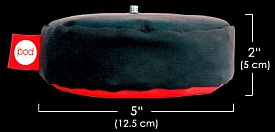Macro photography is one of the most demanding disciplines of photography. The world of the small is a strange and unique place and makes some unusual demands on a photographer interested in capturing its beauty. Razor thin depth of field, extremely close working distances, and long exposure times combine to make macro photography a challenge. But it’s a challenge with a reward. Macros reveal a world that can’t be seen with the naked eye, alien landscapes, and strange creatures both beautiful and grotesque. I encourage you to try it. Many who do find a passion for macro photography they never knew existed.
… Continue reading An introduction to macro and close-up photography

 The Pod is essentially a fancy-pants version of the classic “beanbag tripod,” a device that photographers have been using for years as a makeshift tripod. The Pod people claim that The Pod “takes the shake out” and is a “breakthrough in effortless camera set-up.” Continue reading my review to find out what I thought of it and to have a shot at winning your own Pod.
The Pod is essentially a fancy-pants version of the classic “beanbag tripod,” a device that photographers have been using for years as a makeshift tripod. The Pod people claim that The Pod “takes the shake out” and is a “breakthrough in effortless camera set-up.” Continue reading my review to find out what I thought of it and to have a shot at winning your own Pod.






